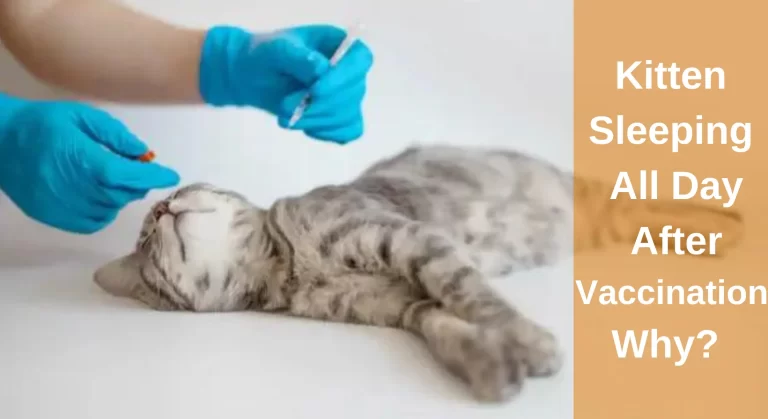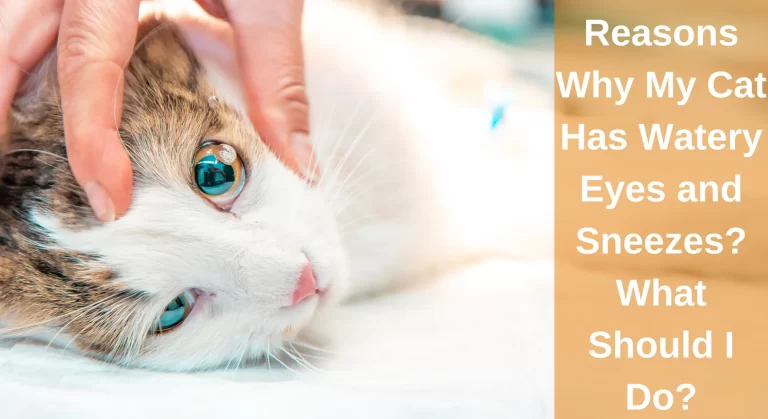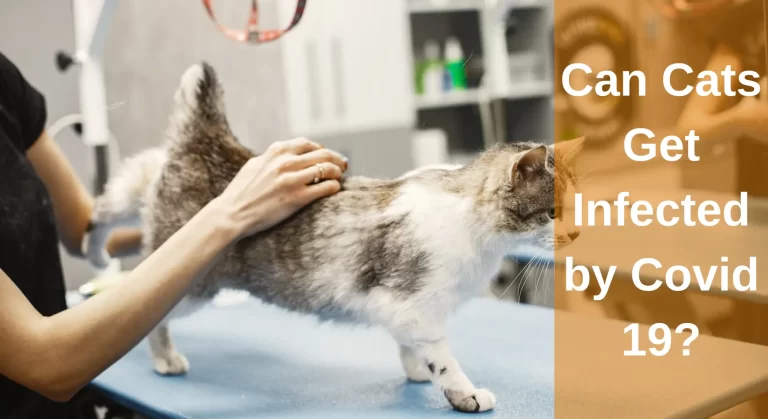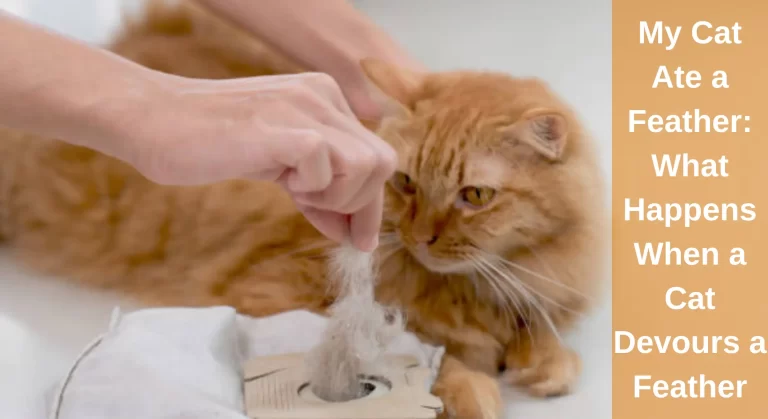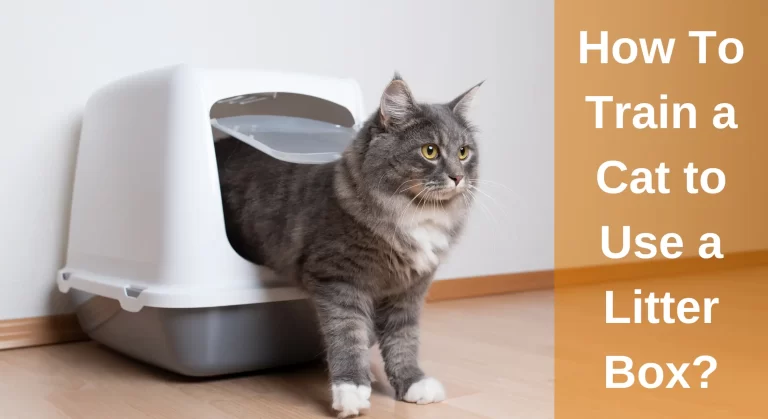What Causes Matted Cat Fur? A Guide To Preventing And Removing Matted Cat Hair
Felines are exceptional self-groomers who devote much of their lives to it. While cats are excellent at grooming, matting can and frequently happens, particularly in curly or long-haired cats. However, most cat owners are unaware of this matting term and constantly ask, “why did my feline’s fur become matted?”.
Matted cat fur is caused by a lack of grooming or inadequate grooming, which allows loose hair to become tangled and knotted with other hairs. Dirt, debris, and oils can also contribute to matting by making the hair sticky and more prone to tangling. In some cases, underlying medical conditions or skin irritations can also cause matting by making the cat more likely to scratch or lick at their fur, leading to tangles and mats.
Matted fur can be uncomfortable for cats, causing skin irritation and even infections if left untreated.
In this article, we’ll mention potential causes, solutions, and information on the risks associated with matted felines’ fur. So, let’s get started:
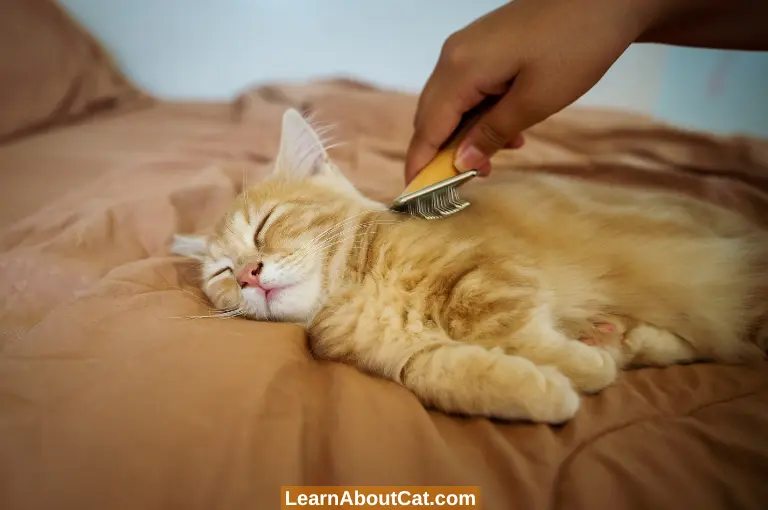
What Causes Matted Cat Fur?
Matted cat hair is defined as cat hair that has become overly knotted and tangled. These knots will start off loose, but as time goes on, they’ll tighten up and get bigger, tangle more hair, and become almost impossible to unravel.
Breeds with long hair, such as Persians, Ragdolls, and Maine Coons, are more likely to develop matted fur. What causes matted cat fur, then? Several things might be causing your cat’s coat to tangle and clump.
1. Shedding of Their Undercoat
Cats are more prone to matting when their undercoat is thinning. This is a common and healthful exercise that helps your cat adjust to changes in seasonal temperature.
The winter months are when your cat’s coat is at its thickest, but in the spring, it sheds in preparation for the summer. Because they shed their fur far more regularly than short-haired cats do, long-haired cat breeds are more susceptible to getting matted fur.
Also Read: Why Is My Cat’s Fur So Soft?
2. Self-Grooming Problems
Although frequent movement and loss of the undercoat can both promote matted cat hair, changes in a cat’s grooming practice are the primary culprits. This is especially likely if your cat has just developed matted fur or is an elderly cat and typically doesn’t have it.
Cats often comb their fur with the bristles on their mouths to remove any dirt or extra oils. Your cat’s fur will mat if they stop grooming or cut back on how much time they spend doing it. It would quickly become a matted mess if we didn’t comb our hair for weeks.
Find Out: Why Is My Cat’s Fur Turning Yellow?
3. Humidity
Moisture is another common cause of matted cat fur. Wet fur is more likely to tangle and knot, especially in long-haired cats.
This can occur when a cat gets wet from rain, snow, or a bath. Especially in the spring and fall, when shedding is at its greatest, this might easily lead to matting. Moisture can also occur from excessive grooming, such as licking or drooling.
4. Underlying Health Issues
Underlying health issues can also cause matted cat fur. Skin conditions, allergies, and parasites can all lead to a cat’s fur becoming tangled and knotted. It is important to address any health issues promptly to prevent them from causing further problems.
Matting might be caused by infections or skin lesions that leak readily. This can then restrict airflow, aggravating the underlying condition.
5. Behavioural Issues
Behavioural issues can also contribute to matted cat fur. Cats that are anxious or stressed may groom themselves excessively, leading to tangled and matted fur.
Additionally, cats that are not provided with enough mental and physical stimulation may become bored and turn to excessive grooming as a way to entertain themselves.
6. Age
A healthy cat can nearly completely bend her spine to clean every nook and cranny. However, cats’ movement deteriorates with age, making it more difficult to brush those hard-to-reach regions.
The worst-affected areas are the back, hips, and base of the tail; these greasy hair patches may ultimately mat.
7. Bread
Some cat breeds are more likely to mat because their undercoats are thicker. Breeds with thick, luxuriant coats consist of:
- Persians\sHimalayans
- Maine’s Coons
- Norwegian Ragdoll Forest cats
- Russian blue ancestors from Siberia produce extra bodily oils.
- Seborrheic cats, intact cats, especially male cats, and cats with hyperthyroid disease
Cats with long hair are more prone to matted fur than short-haired breeds. Their hair can easily become tangled and form knots, especially if they’re not brushed regularly.
8. Weight
Cats that are overweight are unable to turn or reach certain parts of the body, which means they cannot adequately groom themselves.
As a result, the fur can become matted. Additionally, excess body fat can lead to excess oil buildup, which can lead to matted hair.
9. Excess Body Oils
There is a possibility that your cat suffers from hyperthyroidism or seborrheic dermatitis. As a result, there can also be a buildup of excess body oils, resulting in matted fur.
10. Frequent Movement
When furs are rubbed together, fur mats may also form. This explains why your cat’s hair tends to mat most frequently in areas of high friction.
For instance, furs in the shin area may become matted if your outdoor cat has long hair because it brushes up against other hairs when it walks. Their chest may mat beneath the collar for the same reason.
How to Prevent Matted Cat Fur?
It is far simpler to prevent matted cat hair than to remove it. It could be time for you to intervene if your cat has long hair, you are aware that your cat sheds, or you have seen a decline in self-grooming. So pay attention to these tips to help your cat with grooming and prevent cat hair matting.

1. Frequently Brush Your Cat
Brushing your cat’s fur often is the simplest way to prevent matting. This is particularly true if you have a breed of long-haired cats because they tend to develop matted fur more easily and frequently.
Grooming your cat can help prevent matting, which can happen if it doesn’t shed or groom itself. Detangling the hair, dispersing the natural oils on the surface, and removing any dirt or stray hairs that your cat might have missed are all things you can help with.
Grooming not only helps prevent mats but also helps distribute natural oils throughout the coat, keeping it healthy and shiny.
2. Reduce Knots and Tangles
Even if you brush your cat often, knots can still form in between sessions. The sooner you spot a knot, the simpler it will be to disentangle it.
Make it a routine when you pet or groom your cat to frequently check her coat for knots. Problem areas include the crotch and rear, beneath the collar, in the space between the back legs, and behind the ears. These areas should receive your focus.
3. Keep Your Cat Dry
Wet fur is more likely to become matted, so it is important to keep your cat dry. This is especially true for cats that like to spend time outdoors or near water.
If your cat gets wet, be sure to towel dry them thoroughly as soon as possible to prevent mats from forming.
4. Use a Groomer Who is Professional
If your cat does not respond well to brushing or has long fur that is particularly prone to becoming knotted and tangled, you may wish to hire a professional cat groomer. These experts will be familiar with all the techniques and recommendations to guarantee that your cat is well-groomed.
If you choose to engage the groomer, inquire about their practices. By doing this, you can make sure they are carrying out their responsibilities properly and gain some valuable advice for yourself.
5. Take Care of the Diet of Your Cat
Providing your cat with a wholesome, well-balanced diet is also essential. In order to keep your cat’s fur coat appearing clean and smooth for as long as possible, make sure they are fit and healthy. Overweight cats are more prone to matting since they are unable to self-groom effectively.
Obesity is a substantial arthritis risk factor. Because of the added stress caused by your cat’s weight, its joints will age more rapidly than they otherwise would. Elderly cats can still develop Arthritis even at a healthy weight, but delaying the onset by maintaining your cat at a healthy weight will help.
6. Consider a shorter haircut
If your cat’s fur is especially prone to matting, consider giving them a shorter haircut. A shorter haircut can help prevent mats from forming, but it is important to consult with your vet before making any major changes to your cat’s fur.
How To Safely Remove Matted Cat Hair?
Dematting a cat is not a fun process and requires cautious execution. Otherwise, it could hurt your cat or harm its coat permanently. Fortunately, there are several ways to remove matted cat hair, from using a cat-specific de-matting comb to create your own cat detangler spray.
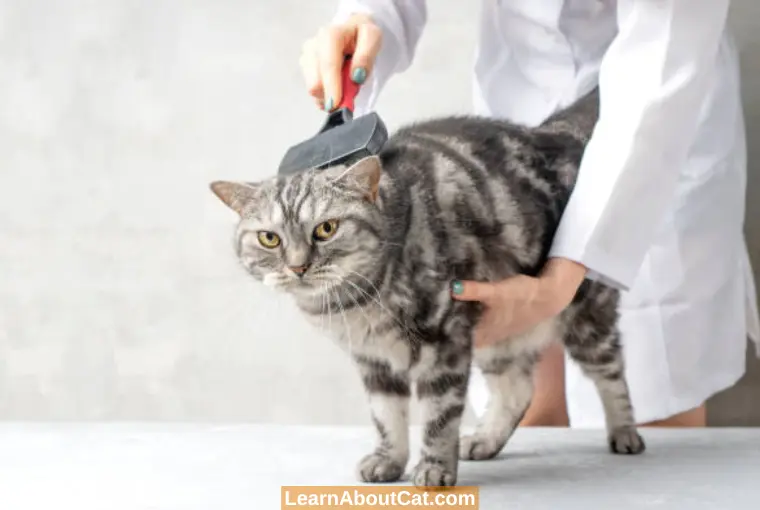
1. Utilise a De-Matting Comb
The best solution for cats with severe matting is to use a de-matting comb for cats. Dematting combs feature a handle and a brush head, as conventional combs do. The comb’s usual teeth have been replaced by short blades, though.
As it brushes across the mat, this instrument saws through and slices away any clumps that are resistant to separation. A de-matting comb for cats with matted hair can be harmful if used improperly since it is sharp. Therefore, before using this comb, make sure your cat is completely at peace and accustomed to being brushed.
2. Use Homemade Cat Detangling Spray
You may manufacture your own detangler spray at home using ordinary household items to get rid of matted cat hair instead of purchasing one from the pet store.
In addition to saving you time by eliminating the need to travel elsewhere, many business owners like using more natural ingredients.
DIY detangler sprays are a great option if the environment is more important to you. To assist in untangling your cat’s matted fur, you may also use coconut oil, baby oil, and olive oil.
3. Hire a Professional
You might want to take your cat to a professional if all else fails and it is terribly matted.
Most mats won’t affect the skin below; all that will be harmed is your cat’s fur. If so, the matted hair clumps can be removed with the help of a cat groomer. They will either use clippers to delicately remove the matted area or comb through the hair while utilising a combination of matted cat hair treatments and detanglers.
If your long-haired cat regularly has matted fur, you might want to ask the groomer if there is a style they can clip the fur into all over to help prevent mats.
4. Put a Wide-Toothed Comb to Use
If your cat’s coat is matted and has short hair, you might be able to remove the matted clumps by brushing them out with a wide-tooth comb. Normal brushes should never be used instead of wide-toothed combs because they leave smaller crevices between the teeth, which increases irritation. But your cat could suffer agonising agony just from tugging at the tangles!
To make the procedure as comfortable as possible, adhere to the following guidelines.
- Always brush out the mat while holding your cat’s fur in one hand closest to its skin.
- Always brush in the direction of the hair’s tip, away from the skin. If not, you will merely backcomb the hair, not untangle it, which will only make the knot deeper. Slide the knots closer to the ends of the strands in order to untie them.
5. Use a Detangler for Matted Fur
Another option is to use a treatment or detangling spray that can be purchased in stores to get rid of matted cat hair. By helping to dissolve the connections keeping the hair together, these products are designed to help release the mats in your cat’s coat.
Many cat owners prefer using a detangler instead of a de-matting comb to remove matted fur since it is far safer and less dangerous to cats. However, you must always use products that are created specifically for cats. Otherwise, the product could slightly irritate their skin.
What Are the Dangers of Matted Cat Hair?
Keep your cat’s coat in good condition by removing any matted fur as soon as possible. Cats can become very uncomfortable and then suffer from health problems if that minor nuisance is not controlled. Cats have a reputation for concealing their pain.
It’s the owner’s responsibility to keep an eye on their behavior and notice any changes to it if they appear in pain. Because they don’t talk to us, we don’t know when they are in pain.
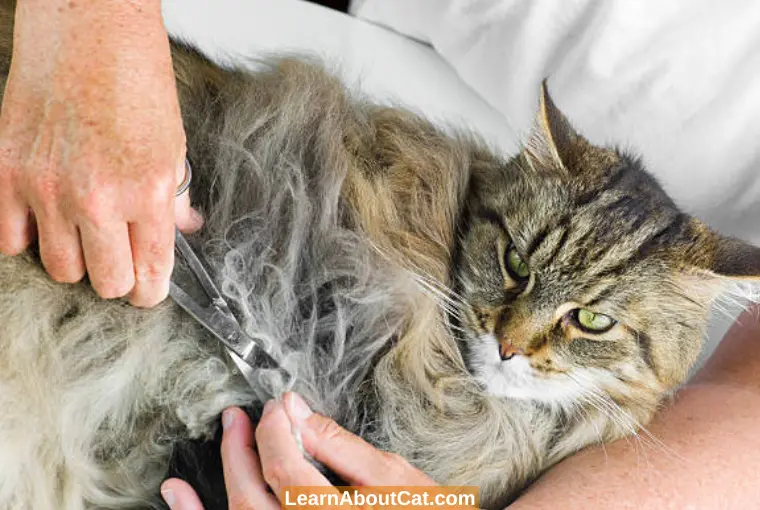
- Mats become tighter over time, and the cat’s skin becomes hot and itchy, causing significant discomfort and pain.
- It is possible for the skin to become infected if it is irritated and inflamed over time.
- Matted fur is also a breeding ground for parasites. It’s well-known that ticks and fleas can be dangerous to your pets if they are not controlled.
- If the cat has extreme cases of matting, it may have to be shaved and put under anaesthesia.
How to Detangle Matted Cat Fur?
Mats may appear like a significant problem, but if you’re willing to be patient, you can easily get rid of them from your cat’s coat. Here is a technique that works for eliminating matted cat hair.
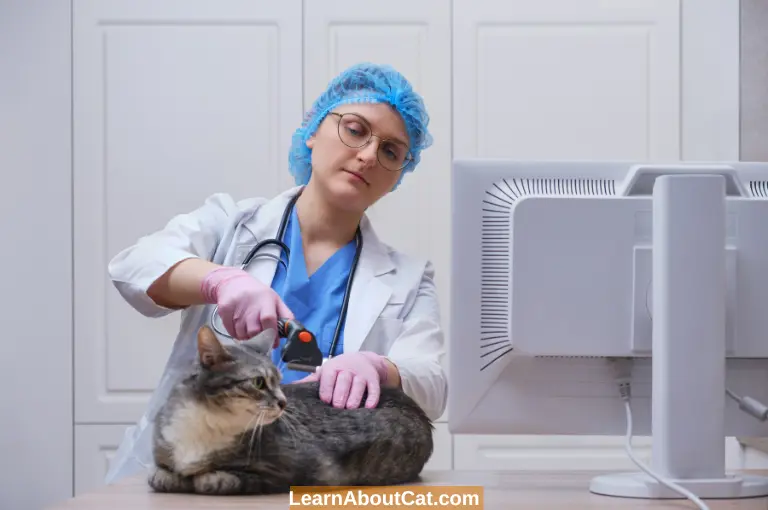
- Start by first separating the mat with your fingertips. The skin may get more irritated or injured if you pull or tug on the mat too hard.
- Next, get the comb out. A flea comb or metal mat is the best option. Clip the knotted fur into little pieces and keep the hair beneath the mat near to the skin. Apply as delicately as you can with quick, short strokes to avoid pulling the skin.
- Continue combing the mat, stopping to let your cat out as needed. When mats are removed, cats might feel heated and agitated, so read the room while you work and give your cat a chance to rest if required.
- Avoid using scissors on the mat to prevent damage. Never try to cut a mat off. When mats form close to a cat’s delicate skin, it is simple to err and cut too deeply.
- Never wash a cat with matted fur. Matthes cautioned against washing a matted cat, even if you have one of the few cats that would let it. The matting can still be removed, but it becomes more challenging. Remove any mats before getting in the tub.
- Finally, if the mat is resisting excessively, seek professional guidance. Sometimes you just have to admit defeat when it comes to cat hair knots if your fingers or a mat comb can’t get rid of it.
Tips on How to De-Mat a Cat
It’s crucial to remember that before you begin, de-matting your cat won’t probably be a very nice experience for either of you. However, you can lessen the discomfort. Put together all of your tools; that’s what you should do.
As the first item on your list, make sure you have everything you require close at hand, including:
- Cutting-edge scissors.
- A little toothcomb, a spray bottle, and water and conditioner.
- Powdered talcum or cornstarch.
- Having some of the best cat treats on hand will also enable you to express gratitude to your cat for maintaining his composure.
Make Some Space
Before attempting to remove the mat, dust it with some cornstarch or talcum powder. The mat should then be carefully and gently pulled up and away from the skin using your fingers. While doing this operation, talk to your cat in a calm tone and reward good behaviour with treats. If they experience any anxiety throughout the process, stop it and start over.
We caution you against trying to solve this problem on your own at home. Instead, schedule a consultation with your veterinarian so they can advise you on the best course of action.
Make Rug Trim
Once you’ve raised the mat enough to reveal the flesh beneath, you can start cutting. To prevent hurting your cat, use blunt-nosed scissors, but make sure they are sharp enough to swiftly and precisely remove the mat. Until you reach the mat, slide the scissors over the skin while holding them perpendicular to it. Continue until every mat has been removed.
Deal With the Little Knots
After removing all the mats, you should take care of any knots that haven’t yet been matted by gently combing them through until all the hair is undone while spraying them with conditioner and water.
How to Prevent Cat Issues When De-Matting?
Before putting your cat to sleep, give her one final treat. Don’t try to remove the mats all at once; it may take several days, depending on how terrible they are, and your cat’s cooperation and patience are required.
- Using a little slicker brush, any remaining knots can then be gently combed through on short-haired cats.
- Serious matted cats require medical attention. After brief anaesthesia, all impacted mats are removed from the hair coats of the affected cats. Also, make sure to keep up a regular brushing and combing routine until the coat grows back to avoid further issues.
Tips
- Never wash a cat before removing a mat. Later on, you’ll simply encounter greater difficulties.
- If the tangles are small and haven’t yet felted or formed, you might want to try spraying a hair conditioner before combing. Instead of using an aerosol, use a pump-style spray to prevent startling your cat.
Why Has My Cat Stopped Self-Grooming?
Cats are naturally skilled self-groomers who utilise their tongue and flexibility to ensure no surface is left uncleaned. If your cat stops grooming itself, its hair might become matted, unhygienic, and tangled.
Actually, there are several reasons why your cat’s fur is matted, including a deficiency in self-grooming. Some of them are listed below
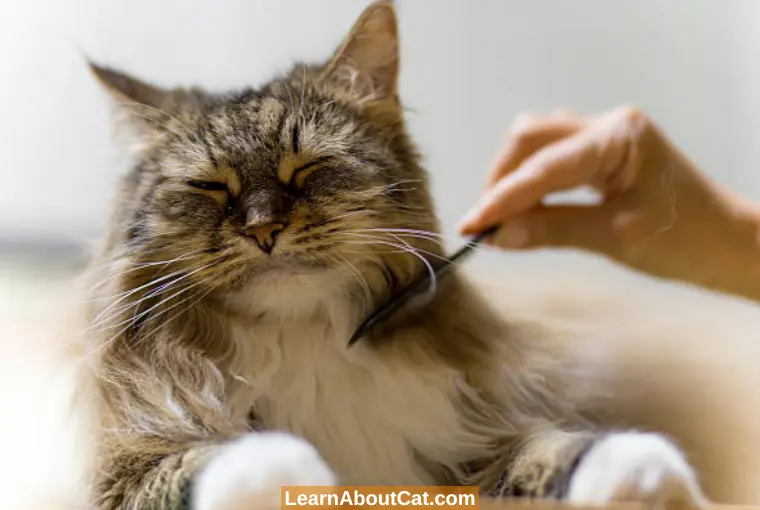
1. There have Dental Problems
Your cat uses its tongue and lips to groom itself. Because of this, if your cat has dental issues, it might not want to clean itself.
Several different dental issues might cause your cat to cease grooming. Gum inflammation, a mouth infection, or tooth and gum disease could bring it on. Another common source of oral pain in cats is oral tumours, which owners may not be aware of since they often develop under the tongue.
2. They are Stressed Out
Although this varies from cat to cat, stress may make your cat less likely to brush themselves. Some cats may over-groom themselves while under stress, which can lead to bald patches and hair loss. However, some cats will entirely stop grooming.
Consider any recent changes if you think your cat’s unusual grooming habits may be stress-related. A new resident or pet, loud noises like those heard during construction, a fireworks display, or even just a shift in their usual routine might be the cause.
3. They are Overweight
Being able to adapt immensely helps cats when it comes to grooming. It suggests that they can efficiently clean themselves from head to toe and assemble themselves into a number of bizarre forms.
Obese or overweight cats, however, may have lost some of their flexibility and may be unable to reach all of their body parts due to their weight. They would like to groom themselves but can’t because of their size.
4. They have Arthritis
It’s conceivable that an elderly cat with matted fur stopped combing because of pain, such as arthritic pain. These painful, swollen joints usually damage the spine in felines, making it unpleasant and rigid. The most frequent cause of matted fur on a cat’s back is spinal Arthritis. Because self-grooming stresses their joints, your cat avoids doing it.
5. They are Experiencing illness
It’s also possible that your cat is not feeling well and doesn’t actually have a serious condition, such as chronic Arthritis or obesity. Similar to how sick humans frequently lose interest in their usual pastimes, your cats may start to lose interest in them. One of the first things to go is self-grooming.
There may be other indications as well, such as if your cat appears sick or unwell, for instance:
- Loss of appetite and weight.
- Increased thirst.
- Greater amounts of pee in their litter box indicate illness or diarrhoea.
- Changes in behaviour or mood.
- Numerous things might be the cause of your cat’s sickness.
Also Read: Why Is My Cat’s Hair Oily And Clumping?
Frequently Asked Questions
Is matted fur painful for cats?
Yes, mats cause extreme pain. Fur that’s twisted and braided on itself forms mats. They apply a lot of pressure on felines’ skin which could possibly result in bruises. Skin that has been compressed tightly by matting can actually rip since it’s so fragile and sensitive.
Do cats get matted when stressed?
Yes, stress increases the likelihood that your cat will decrease its grooming. Under stress, cats can also overgroom themselves, resulting in hair loss. Some cats, nevertheless, will completely quit grooming, due to which mating can occur.
Does olive oil remove mats from cats?
Oil is among the most widely used natural treatments for feline mats because it makes it easier to remove the mat by allowing the hair fibres to separate easily from each other. Some cat owners advise using baby oil. However, olive oil for cat matting is a better, less chemically laden alternative for removing mats from cats’ skin.
Should I bathe a matted cat?
If your cat gets matted, don’t ever bathe them. It is advised by professionals that you must remove mats as they get tightened, which makes it more challenging to release the matting.
How often should I groom my cat to prevent matted fur?
You should groom your cat regularly, at least once or twice a week, to prevent matted fur from forming. This is especially important for cats with long hair or thick coats.
Can I use human hair detangler spray on my cat?
No, you should never use human hair detangler spray on your cat. These products can be toxic to cats and cause serious health problems.
Can shaving my cat prevent matted fur?
Shaving your cat can help prevent matted fur, especially if they have long hair or a thick coat. However, shaving can also be stressful for cats, so it is important to consult with your vet before deciding to shave your cat.
Can I use scissors to cut out mats on my own?
No, using a regular comb or brush to remove matted cat hair can be painful and even injure your cat. Use the appropriate tool, such as scissors, clippers, or a mat splitter, to safely remove mats.
What are the signs of matted cat fur?
Signs of matted cat fur include clumps or knots in the cat’s fur, especially around the armpits, belly, and hindquarters. Your cat may also seem uncomfortable or restless and may lick or scratch excessively.
Final Words!
The term matted refers to cat hair that has become overly knotted and tangled, trapping dirt inside. Long-haired cats are more likely to acquire mats just from going about their regular lives, including Maine Coons, Ragdolls, and Himalayan cats. However, short-haired breeds are prone to matted fur, which is usually caused by carelessness.
Preventing matted fur is crucial, and it can be done by giving your frequent cat grooming, feeding her a nutritious diet, and eliminating any knots as soon as they form. However, if a matted patch of fur has remained undetected, you may either try one of the methods mentioned earlier to remove it at home or seek professional assistance.
Even though matted cat hair is not a serious concern in and of itself, it can cause a variety of serious issues. Therefore, appropriate prevention and treatment are essential for your cat’s health and happiness. Keep an eye on those mats!
Related Posts:
Who is Isabella?
My name is Isabella, and I am a dedicated and knowledgeable cat enthusiast. With years of experience caring for cats and a deep love for felines, I made a mission to help other cat lovers navigate the challenges of cat ownership.

